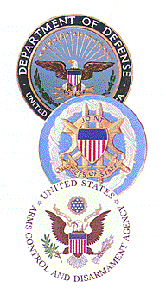 Gates of the Hercules Plant Number 1 at Magna, Utah, site of the Soviet Union's continuous portal monitoring inspections. |
General Daniel led the overall effort. Major Paul P. Trahan, U.S. Army, task force member and an armor officer trained in organizational theory and corporate planning, began analyzing and visualizing the treaty's requirements for inspectors, escorts, and aircrews. He developed a briefing concept illustrating the types of on-site inspections, the years they were permitted, and the level of people required. Working together, Daniel and Trahan incorporated this concept into a series of briefings presented to the military service chiefs, the chairman, the senior members of the Office of the Secretary of Defense, and the leadership of the Arms Control and Disarmament Agency. Another task force member, Major Jerome E. Johnson, USAF, began working on arrangements for training courses for inspectors and escorts with the Defense Intelligence College. Marine Corps Lt. Colonel Sebastian V. Massimini began defining computer and communications requirements for tracking the INF on-site inspections and treaty-related items. Lt. Commander William G. Evans, U.S. Navy, started defining requirements and resources for Russian linguists. Another Air Force Lt. Colonel, Nicholas G. Caramancia, worked on the difficult issues of air transportation mandated by the rigid schedules written into the Treaty protocols concerning on-site inspections and eliminations. Lt. Commander Robert P. Barton, U.S. Navy, and Army Captain Leon Hutton, developed initial cost estimates of personnel, transportation, and portal housing for the INF mission. Finally, Lt. Colonel Ken Keating, U.S. Army, who had experience as an INF negotiator in Geneva, helped with all manner of issues: logistics, linguists, operations, and organizational structure.2 |

